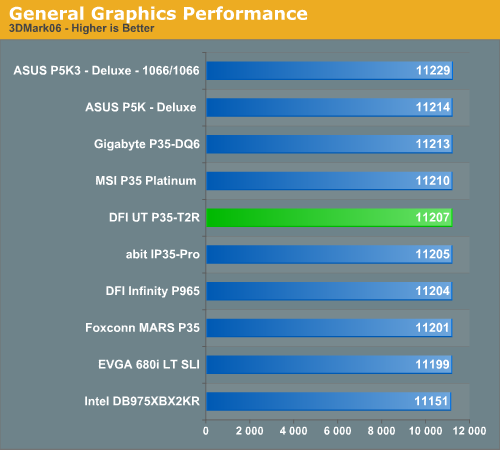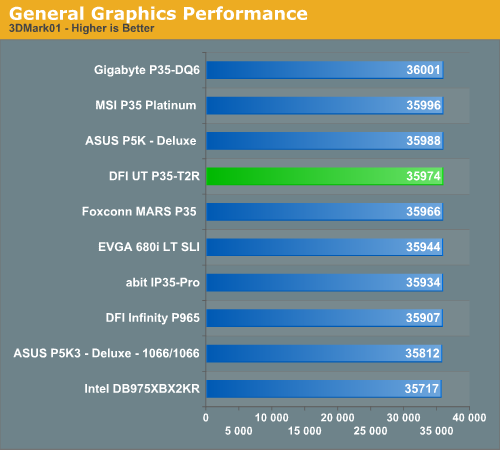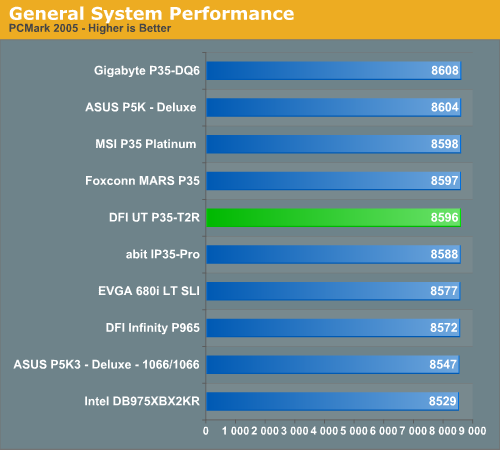DFI UT P35-T2R: Tweakers Rejoice!
by Rajinder Gill on October 18, 2007 2:00 PM EST- Posted in
- Motherboards
Synthetic Graphics Performance
The 3DMark series of benchmarks developed and provided by Futuremark are among the most widely used tools for benchmark reporting and comparisons. Although the benchmarks are very useful for providing apples-to-apples comparisons across a broad array of GPU and CPU configurations, they are not a substitute for actual application and gaming benchmarks. In this sense we consider the 3DMark benchmarks to be purely synthetic in nature but still valuable for providing consistent measurements of performance.


In our 3DMark06 test, the P35 boards are basically even in this test. The DFI board did not exhibit any issues during repeated testing in this CPU/GPU intensive test. In the more memory and CPU throughput sensitive 3DMark01 benchmark we see our DFI board performing well though it's just slightly off the top mark. We typically see this in the DFI boards that are tuned more for overclocking results than stock performance. The differences in performance are not really noticeable in either 3DMark unless you're looking to reach the top of the ORB. That of course requires some serious overclocking as well, and we have a good feeling the DFI was designed to do exactly that with the right setup.
General System Performance
The PCMark05 benchmark developed and provided by Futuremark was designed for determining overall system performance for the typical home computing user. This tool provides both system and component level benchmarking results utilizing subsets of real world applications or programs. This benchmark is useful for providing comparative results across a broad array of Graphics, CPU, Hard Disk, and Memory configurations along with multithreading results. In this sense we consider the PCMark benchmark to be both synthetic and real world in nature, and it again provides for consistency in our benchmark results.

Our PCMark05 scores mimic the results from our 3DMark benchmarks with differences between the boards not exceeding 2%. While this benchmark is designed around actual application usage, we will see if these results mirror our application testing.
The 3DMark series of benchmarks developed and provided by Futuremark are among the most widely used tools for benchmark reporting and comparisons. Although the benchmarks are very useful for providing apples-to-apples comparisons across a broad array of GPU and CPU configurations, they are not a substitute for actual application and gaming benchmarks. In this sense we consider the 3DMark benchmarks to be purely synthetic in nature but still valuable for providing consistent measurements of performance.


In our 3DMark06 test, the P35 boards are basically even in this test. The DFI board did not exhibit any issues during repeated testing in this CPU/GPU intensive test. In the more memory and CPU throughput sensitive 3DMark01 benchmark we see our DFI board performing well though it's just slightly off the top mark. We typically see this in the DFI boards that are tuned more for overclocking results than stock performance. The differences in performance are not really noticeable in either 3DMark unless you're looking to reach the top of the ORB. That of course requires some serious overclocking as well, and we have a good feeling the DFI was designed to do exactly that with the right setup.
General System Performance
The PCMark05 benchmark developed and provided by Futuremark was designed for determining overall system performance for the typical home computing user. This tool provides both system and component level benchmarking results utilizing subsets of real world applications or programs. This benchmark is useful for providing comparative results across a broad array of Graphics, CPU, Hard Disk, and Memory configurations along with multithreading results. In this sense we consider the PCMark benchmark to be both synthetic and real world in nature, and it again provides for consistency in our benchmark results.

Our PCMark05 scores mimic the results from our 3DMark benchmarks with differences between the boards not exceeding 2%. While this benchmark is designed around actual application usage, we will see if these results mirror our application testing.










30 Comments
View All Comments
Acanthus - Thursday, October 18, 2007 - link
Although all of the tweaking options provided are nice, it literally does no better than Asus P5K Deluxe or the Gigabyte P35-DQ6.Furthermore with X38 boards on the way, im not seeing a whole lot of incentive for this $300 motherboard.
Just my $.02
retrospooty - Thursday, October 18, 2007 - link
This board has hit 672mhz FSB, far FAR higher than any other other board ever, including early samples of X38. Not likely to be matched until the DFI X38 comes out.http://www.xtremesystems.org/forums/showthread.php...">http://www.xtremesystems.org/forums/showthread.php...
This link shows it at 666mhz, I cant find the 672mhz one at the moment, but its on the same forum, by the same guy with the same golden CPU.
cmdrdredd - Thursday, October 18, 2007 - link
Not usable 24/7WHO CARES!?
retrospooty - Thursday, October 18, 2007 - link
Well, it still goes alot higher than the others you mentioned, it is absolutely the best overclocking motherboard available. - that was what I responded too, obviously its not the one for you.Acanthus - Thursday, October 18, 2007 - link
That is from the DFI labs... with a beta board... on supercooling...and volt mods... on a dual core CPU that doesnt stress the PWMs...Anandtechs results even using phase dont approach those results.
retrospooty - Friday, October 19, 2007 - link
No, that is not from DFI labs, that is an independant dood, and CPU's that hit that high FSB are pretty rare.Whatever man, you can poo poo it all you want. It is the best OC mobo out there, and goes higher and takes it farther than any other. It may not be the one for you though.
Raja Gill - Thursday, October 18, 2007 - link
You need to remember that this board was compared at stock settings, not OC'ed, things change up top...;), not to mention we could not get the board to crash..regards
Raja
Acanthus - Thursday, October 18, 2007 - link
Its the same chipset, its not going magically increase in a non-linear fashion.The P5K and DQ6 hit the same maximum overclock.
MadBoris - Thursday, October 18, 2007 - link
It makes sense that article takes a different approach, customers of this board or tweakers in general, will really appreciate the fine details.Personally, in the last ten years I have gotten to a place where I am very comfortable not pushing for the last 100 - 300 mhz. The meager tangible return is not worth all the extra voltage or potential stability issues that often come up later in the life of the HW due to creep, dust, aging paste, etc. I get a nice stress test capable OC, then back it up a notch. I won't win any 3dmark awards that way though but am very satisfied with stability when a new product stresses HW in ways not stressed before.
One thing for sure with this board, I wouldn't want to lose the CMOS, then have to remember all my settings after a year.
Nice board and good article, $300 is too much though for a MB for me. It's definitely elite.
retrospooty - Thursday, October 18, 2007 - link
Its alot of reading, but that is because the DFI is alot of motherboard. I have had it since it was first released and loving every minute of it. I have a C2D 6750 running at 8x500 fsb for a sweet 4 ghz on water at DDR2 1000 4-4-4-10 timing, man is it sweet.There are sooooo many bios tweaks to get better performance, or stability at high overclock - its definitely not for beginners... worth every penny of the $300 I spent.